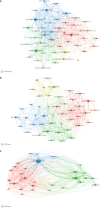Global trends of purinergic receptors and depression: A bibliometric analysis from 2003 to 2023
- PMID: 39974485
- PMCID: PMC11758036
- DOI: 10.5498/wjp.v15.i2.102344
Global trends of purinergic receptors and depression: A bibliometric analysis from 2003 to 2023
Abstract
Background: Depression significantly threatens human health. Purinergic receptors are reported to be associated with depression. However, there is no bibliometric research in this field have been published.
Aim: To provide some reference for the further research in the field of purinergic receptors and depression utilizing bibliometric analysis.
Methods: Relevant researches were retrieved from the Web of Science Core Collection database. The period of the search was from January 1, 2003 to December 31, 2023. The CiteSpace (6.2.R7) and VOSviewer (1.6.19) were applied to identify the main contributors of countries, authors, institutions, references and journals. Besides, we evaluate keywords to assess the hotspots and trends over the previous 2 decades.
Results: Totally, 247 articles were identified, showing an increasing trend over time. The most productive country, institution, and journal in this field are China, Harvard University, and Biological Psychiatry, respectively. Liang SD and Rodrigues, Ana Lucia S were the most prolific authors. Burnstock G ranked first among the cited authors. The cooperation among countries and disciplines is crucial. The P2X7 receptor provides promising prospects for treating depression and further studies are warranted to validate the scope and significance of depression therapeutic strategies.
Conclusion: This study provides an overview of the worldwide research status and future trends in purinergic receptors and depression. P2X7 receptor is considered an appropriate target for the treatment of depression, as well as neurological diseases. It is implied that based on purinergic system, the future prospects for interventions aimed at depression treatment are promising, showing the way for both augmentation strategies and new drug treatments in the context of the pharmacology of depression.
Keywords: Bibliometric analysis; CiteSpace; Depression; Purinergic receptors; Research trend.
©The Author(s) 2025. Published by Baishideng Publishing Group Inc. All rights reserved.
Conflict of interest statement
Conflict-of-interest statement: The authors declare that they have no conflict of interest.
Figures







References
-
- Herrman H, Kieling C, McGorry P, Horton R, Sargent J, Patel V. Reducing the global burden of depression: a Lancet-World Psychiatric Association Commission. Lancet. 2019;393:e42–e43. - PubMed
-
- Huang Y, Wang Y, Wang H, Liu Z, Yu X, Yan J, Yu Y, Kou C, Xu X, Lu J, Wang Z, He S, Xu Y, He Y, Li T, Guo W, Tian H, Xu G, Xu X, Ma Y, Wang L, Wang L, Yan Y, Wang B, Xiao S, Zhou L, Li L, Tan L, Zhang T, Ma C, Li Q, Ding H, Geng H, Jia F, Shi J, Wang S, Zhang N, Du X, Du X, Wu Y. Prevalence of mental disorders in China: a cross-sectional epidemiological study. Lancet Psychiatry. 2019;6:211–224. - PubMed
-
- Abdoli N, Salari N, Darvishi N, Jafarpour S, Solaymani M, Mohammadi M, Shohaimi S. The global prevalence of major depressive disorder (MDD) among the elderly: A systematic review and meta-analysis. Neurosci Biobehav Rev. 2022;132:1067–1073. - PubMed
-
- Greenberg PE, Birnbaum HG. The economic burden of depression in the US: societal and patient perspectives. Expert Opin Pharmacother. 2005;6:369–376. - PubMed
LinkOut - more resources
Full Text Sources

